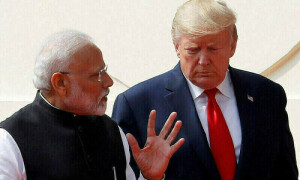KARACHI, May 2: The exchange rate mechanism seems to be going out of control of the State Bank of Pakistan as the bullish greenback breaks all barriers to set a new record by sinking the local currency to an all-time low on Friday.
Dozens of researchers and experts working inside the tall building of the Central Bank apparently failed to devise any strategy or create some tools to check the free fall of the Pakistani rupee against the US dollar, the currency itself fastest losing paper in world currency market.
“We traded the US dollar as high as Rs65.22 in the inter-bank market,” said Atif Ali, a currency dealer.
He said it wouldn’t be shocking for him if the rupee falls further in the next few days.
“The demand is much higher than the inflows, which has disrupted the entire mechanism of inflow and outflow,” said Ali.
The inter-bank market closed just below Rs65 against the US dollar. However, the open market, run by the exchange companies, also failed to follow rates set by the SBP.
The SBP issued a series of circulars on Wednesday, tightening the open market, and suspended two B category exchange companies for rules violation.
The companies were also asked to sell more dollars in inter-bank market as compared to a previous limit.
“The State Bank should control the inter-bank before, putting a pressure on the exchange companies as it was a smaller market than the inter-bank market,” said an exchange company owner.
The exchange companies have an estimated market of $15 million while the inter-bank market is of around $250 to $300 million.
The SBP has bounded the exchange companies to charge only up 40 paisa more than the rate of the dollar in the inter-bank market.
However, dollar was traded about Rs67 in the open market. Although notice boards of the exchange companies were flashing rates, these were not applicable to buying and selling, and were only to fulfill a formality.
When the inter-bank market has crossed Rs65, how can money- changers be stopped from earning as there is a high demand, asked a money-changer who stated that a black market of currencies had emerged in Karachi where a substantial amount of dollar was available at a rate much higher than the SBP’s prescribed one and even higher than the exchange companies.
“The shortage and continued high demand is the real reason for this situation,” said an exchange company owner.
Last week the federal finance minister had announced that the government would borrow $3 billion to improve foreign exchange reserves and meet the rising deficits prevailing in each corner of the national economy.
When asked, bankers said the outflow of dollar to make payments, like profits and dividends, have become a regular feature of economy due to heavy foreign investment in the services sector, like telecommunications and banking.
Bankers feel that policy-makers have failed to devise an exchange rate mechanism which could be effective with the changing situation.
“At first dollars were bought from local market to increase the size of reserves which helped stabilise the exchange rate, but the current situation was not considered. I believe there should be a chaos within the SBP as the situation is going from bad to worse,” said a senior banker.

















































Dear visitor, the comments section is undergoing an overhaul and will return soon.